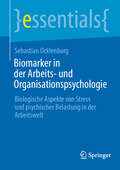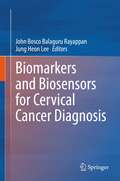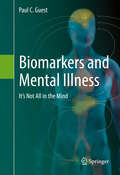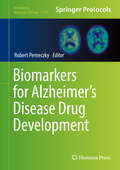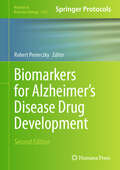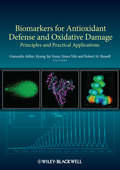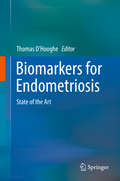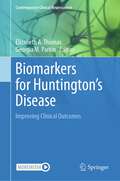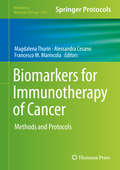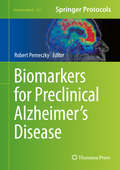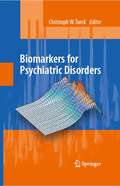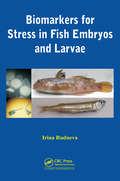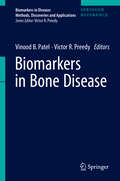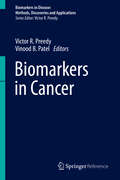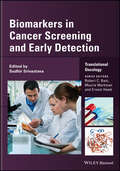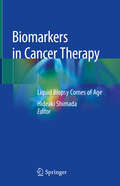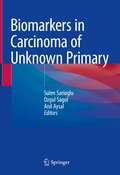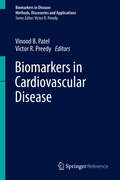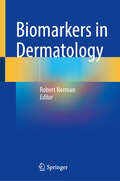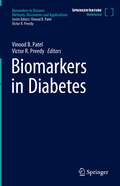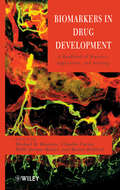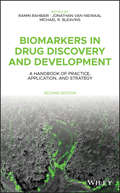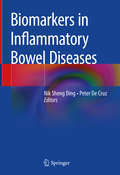- Table View
- List View
Biomarker in der Arbeits- und Organisationspsychologie: Biologische Aspekte von Stress und psychischer Belastung in der Arbeitswelt (essentials)
by Sebastian OcklenburgDieses essential gibt einen Überblick über Biomarker-Forschung in der Arbeits- und Organisationspsychologie. Dabei werden die zentralen Biomarker und Methoden zur Erfassung von Biomarkern erläutert. Der Autor beleuchtet spezifisch relevante Biomarker für psychische Erkrankungen im Kontext der Arbeitswelt sowie Biomarker für psychische Belastungsfolgen der Arbeit wie Burn-out. Das essential endet mit einer praxisorientierten Erläuterung organisationaler und finanzieller Aspekte von biopsychologischer Forschung in der Arbeitswelt.
Biomarkers And Occupational Health: Progress And Perspectives
by Mortimer L.Mendelsohn John P.Peeters Mary Janet NormandyBiomarkers have emerged as an exciting tool in disease prevention, particularly in the workplace. They may be used to document workers' exposure to toxins, signal the onset of health effects, or identify individuals with susceptibility to certain environmental threats. But the uncertainty is as great as the potential. Are biomarkers suitable for widespread use? How can they be deployed in diverse contexts? How can biological information about workers be handled fairly and ethically?Biomarkers and Occupational Health describes the state of biomarker development, including the implications of the Human Genome program, and presents a range of viewpoints on the future of biomarkers from the leaders in the field.This book explores the three basic types of biomarkers (markers of exposure, markers of health effects, and markers of susceptibility to disease) from a variety of perspectives. It examines what can be learned from well-known exposure sites--Hiroshima and Nagasaki, Chernobyl, and the Hanford nuclear site in the United States, for example--and a wide range of human cases and animal studies. The book also explores the costs and ramifications of developing a large-scale program to monitor potentially exposed workers (e.g., at a cleanup site).A framework is offered for the use of biomarkers based on the mandate to "change the environment before you change the worker." The book explores how to identify ethical issues, how to set development priorities, and how to integrate biomarkers into an occupational health and safety program.The authors present the latest technical findings about markers for chronic beryllium disease as well as markers for exposure to carcinogens, radiation, and chronium--including prospects for detecting long-past exposures.Biomarkers and Occupational Health offers an update on biomarker development and explores a wide scope of issues. This book will be important to occupational health professionals, biomedical researchers, toxicologists, epidemiologists, and labor and management officials involved in worker health issues.Moritmer L. Mendelsohn, M.D., Ph.D., is Vice-Chairman of the Radiation Effects Research Foundation (RERF) in Japan, which studies the long-term health effects of the atomic blasts in Hiroshima and Nagasaki, and he is former Associate Director of the Lawrence Livermore National Laboratory in California.John P. Peeters, Ph.D., is a geneticist who is currently directing a division of the Office of Occupational Medicine for the United States Department of Energy.Mary Janet Normandy, Ph.D., is a toxicologist who specializes in the metabolism of xenobiotics in mammalian systems. She is currently a member of the Department of Energy's Office of Occupational Medicine.
Biomarkers and Biosensors for Cervical Cancer Diagnosis
by John Bosco Balaguru Rayappan Jung Heon LeeThis book highlights both conventional and nanomaterials-based biosensors for the detection of cervical cancers. It describes developments in the selective and sensitive electrochemical biosensors based on DNA for the early diagnosis of cervical cancer. Further, this book covers other nano-biosensing systems such as nano-thermometry-based sensing platforms, mechanical sensing platforms encompassing piezoelectric-based sensors, electrochemical impedance spectroscopy based on PEGylated arginine functionalized magnetic nanoparticles, and field-effect transistor-based platforms for the early detection of cervical cancer. Also, it presents conventional platforms such as vibrational spectroscopy and polymerase chain reaction techniques for the diagnosis of cervical cancer. Finally, it reviews currently available biomarkers for the early diagnosis of cervical cancer and presents strategies for developing novel biomarkers based on cellular and molecular approaches. As such, this book is a comprehensive resource for researchers and clinicians working in cervical cancer diagnostics.
Biomarkers and Mental Illness: It’s Not All in the Mind
by Paul C. GuestEmploying accessible language throughout, this book covers the history of psychiatric research, the current state-of-the art in psychiatric practice, the physiological systems affected by psychiatric illnesses, the whole-body nature of these diseases and the impact that this aspect has on emerging biomarker discoveries. Further, it provides descriptions of the major specific psychiatric disorders and the special challenges regarding the diagnosis and treatment of each. The book concludes with insights into the latest developments in hand-held biomarker test devices, which can provide diagnostic information in less than 15 minutes in point-of-care settings. This book investigates the emerging use of biomarkers in the study of psychiatric diseases, a topic of considerable importance for a broad range of people including researchers, clinicians, psychiatrists, university students and even those whose lives are affected in some way by a psychiatric illness. The last category is hardly trivial, since a staggering one in three people worldwide show the criteria for at least one psychiatric disorder at some point in their lifetime.
Biomarkers for Alzheimer’s Disease Drug Development (Methods In Molecular Biology #1750)
by Robert PerneczkyThis volume aims to build a new generation of experts with a broader understanding of key topics in the Alzheimer’s disease field. Chapters guide readers through innovative approaches to the discovery of novel biomarkers in cerebrospinal fluid, innovation in blood-based biomarkers, a comprehensive overview of magnetic resonance imaging and molecular imaging approaches and their value for developing drugs for Alzheimer’s disease, cutting-edge developments in neuropathology and their relevance for Alzheimer’s disease trials, novel genomic strategies for biomarker development, and related topics including neuropsychological testing and advanced analytical methods.Written in the highly successful Methods in Molecular Biology series format, chapters include introductions to their respective topics, lists of the necessary materials and reagents, step-by-step, readily reproducible laboratory protocols, and tips on troubleshooting and avoiding known pitfalls. Authoritative and cutting-edge, Biomarkers for Alzheimer's Disease Drug Development aims to ensure successful results in the further study of this vital field.
Biomarkers for Alzheimer’s Disease Drug Development (Methods in Molecular Biology #2785)
by Robert PerneczkyThis fully updated volume provides an up-to-date and comprehensive overview of the current state of technologies helping to accelerate Alzheimer’s disease drug development. Addressing the latest advances in preclinical and clinical research, including new insights into the molecular mechanisms and emerging therapeutic strategies, the book continues by exploring digital biomarkers and advanced neuroimaging analysis which will transform how clinical trials in the Alzheimer’s disease field are performed. Written for the highly successful Methods in Molecular Biology series, chapters feature the kind of detailed implementation advice that leads to greater success in the lab or clinic. Authoritative and practical, Biomarkers for Alzheimer’s Disease Drug Development, Second Edition seeks to inspire and inform future efforts to develop effective treatments for this devastating disease.
Biomarkers for Antioxidant Defense and Oxidative Damage: Principles and Practical Applications
by Giancarlo Aldini Kyung-Jin Yeum Etsuo Niki Robert M. RussellBiomarkers for Antioxidant Defense and Oxidative Damage: Principles and Practical Applications critically evaluates the basic concepts and methodologies of conventional biomarkers as well as current state-of-the-art assays for measuring antioxidant activity/oxidative stress and their practical applications. . Biomarkers for Antioxidant Defense and Oxidative Damage: Principles and Practical Applications will be of a great interest to scientists who are involved in basic research on oxidation, applied scientists evaluating the effects of nutraceuticals or pharmaceutical compounds on antioxidant activity/oxidative stress, and physicians who want to understand the degree of oxidative damage in patients with certain chronic diseases. Discovering sensitive and specific biomarkers for systemic oxidative damage is essential to understand the role of oxidative stress in human disease. Once these roles are clearly understood, we are able to identify novel drug and nutraceutical targets. This volume goes beyond conventional analytical methods of measuring overall antioxidant activity and provides insight to the discovery of biomarkers that reveal information on specific areas of oxidative stress. Contributed by an international list of experts, Biomarkers for Antioxidant Defense and Oxidative Damage: Principles and Practical Applications describes both conventional biomarkers and recent developments in this area. Special Features: Discusses conventional biomarkers as well as recent advances for measuring antioxidants and oxidative stress Biomarkers for lipid peroxidation: isoprostane, hydroxyloctadecaenoic acid, oxysterols, and reactive carbonyl species from lipid peroxidation Biomarkers for protein oxidation: carbonylation, tyrosine oxidation, ubiquitin-conjugation Biomarkers for DNA oxidative damage: comet assay, hydroxylated nucleotides, and exocylcic DNA adducts Recently developed biomarkers from cutting-edge technology
Biomarkers for Endometriosis
by Thomas D'HoogheThis book presents an overview of the diagnostic performance of non- or semi-invasive tests for endometriosis in peripheral blood, endometrium, saliva, peritoneal fluid and urine. The value of existing and emerging systems biology technologies for biomarker development is addressed in several chapters on genetics, microarrays, proteomics and metabolomics. Although tests with high sensitivity and acceptable specificity have been developed, sometimes validated in independent populations and seem promising, more research is needed to translate these data into clinical benefit for patients and coordinate efforts internationally to standarize analysis, reports and operating procedures. The gold standard to diagnose endometriosis is currently through laparoscopic inspection with histological confirmation, a surgical procedure with rare but significant potential risks for the patients. A non-invasive test for endometriosis would be critical for the early detection of endometriosis of symptomatic women with pelvic pain and/or subfertility with normal ultrasound. This would include nearly all cases of minimal-mild endometriosis, some cases of moderate-severe endometriosis without a clearly visible ovarian endometrioma and cases with pelvic adhesions and/or other pelvic pathology, who might benefit from surgery to improve pelvic pain and/or subfertility. Such a test would also be useful in symptomatic women with ultrasound imaging suspicious for endometriosis, since it may be difficult to differentiate an ovarian endometrioma from other ovarian cysts and since the quality of ultrasound imaging is highly variable worldwide.
Biomarkers for Huntington's Disease: Improving Clinical Outcomes (Contemporary Clinical Neuroscience)
by Elizabeth A. Thomas Georgia M. ParkinHuntington’s disease (HD) is a fatal, inherited, neurodegenerative disorder, characterized by chorea, motor instabilities, psychiatric manifestations and cognitive decline. Early genetic testing provides an opportunity for clinical interventions aimed at delaying onset and/or slowing progression of disease; however, current treatments for HD are limited, with only two FDA-approved drugs available to manage chorea. Encouragingly, however, several disease-modifying treatment approaches are in the therapeutic pipeline, with more than 200 clinical studies, and many more preclinical studies, in the works. Robust and reliable biomarkers are needed to predict disease onset, monitor disease progression and assess treatment responses. More specifically, biomarkers to stratify patients for clinical trials and biomarkers to track drug efficacy will certainly lead to improved clinical trial design and success. This book represents the first book focused solely on biomarkers for HD and represents a distinct resource that will be informative, not only for clinicians and those involved in clinical trial design, but also for a wide range of neurodegenerative disease researchers. This edited volume is written by top leaders in the field, and takes a cross-disciplinary approach to cover a broad spectrum of biomarker types, in order to provide the latest advances in the development of biochemical, molecular, imaging and digital biomarkers that have been investigated for HD. With the ultimate goal of treating patients, the development of disease-associated biomarkers has never been more important.
Biomarkers for Immunotherapy of Cancer: Methods and Protocols (Methods in Molecular Biology #2055)
by Francesco M. Marincola Magdalena Thurin Alessandra CesanoThis book provides the immune oncology (IO) community with a deeper understanding of the scope of the biomarker methods to potentially improve the outcome from immunotherapy. The editors secured the input from experts in the field dedicated to translating scientific research from bench to bedside was submitted. The book provides not only details about the technical, standardization and interpretation aspects of the methods but also introduces the reader to the background information and scientific justification for selected biomarkers and assays. Written in the highly successful Methods in Molecular Biology series format, chapters include introductions to their respective topics, lists of the necessary materials and reagents, step-by-step, readily reproducible laboratory protocols, and tips on troubleshooting and avoiding known pitfalls.
Biomarkers for Preclinical Alzheimer’s Disease (Neuromethods #137)
by Robert PerneczkyThis volume discusses the importance of imaging, fluid, and genetic biomarkers in detecting the earliest pre-symptomatic stages of Alzheimer’s disease (AD). The chapters in this book are separated into five parts. Part one explores the reasons why we need improved approaches for early detection and diagnosis of AD. Part two describes clinical and research techniques for preclinical AD diagnosis. Part three looks at the current methods in use to diagnose AD and how they can also be used for early detection in healthy older individuals. Parts four and five talk about technological advancements in AD diagnosis and ethical considerations in AD research. In Neuromethods series style, chapters include the kind of detail and key advice from the specialists needed to get successful results in your laboratory.Comprehensive and cutting-edge, Biomarkers for Preclinical Alzheimer’s Disease is a valuable resource for individuals interested in the use of biomarker strategies to improve early AD detection. This book will be of great interest to researchers and clinicians from both academia and industry.”
Biomarkers for Psychiatric Disorders
by Chris TurckBiomarkers hold immense promise for the early detection of disease. Unlike other disorders like diabetes and heart disease where a limited number of biological markers are at hand that allow the physician to come up with a reliable diagnosis, there are currently no such markers available for affective disorders. As in any other disease area a major goal is therefore the identification of early markers that can categorize subsets of subjects in a consistent manner. This will allow a more precise definition and categorization of affective disorders and in turn facilitate investigations of the pathogenesis of the diseases and enhance our ability for treatment. This edited volume will not only address the area of affective disorders but also other brain disorders that are neurological in nature, including Multiple Sclerosis and Alzheimer Disease.
Biomarkers for Stress in Fish Embryos and Larvae
by Irina RudnevaThe present work evaluates the toxic effects of some environmental stressors on fish eggs and larvae and describes the biomarker responses of fish from locations with varying levels of pollution. Development of the main groups of biomarkers is discussed. The book demonstrates general trends and specific peculiarities of biomarker induction in early
Biomarkers for Traumatic Brain Injury: Proceedings Of A Workshop
by Board on Health Sciences Policy National Academies of Sciences, Engineering, and Medicine Health and Medicine Division Forum on Traumatic Brain InjuryThe National Academies Forum on Traumatic Brain Injury (TBI) convened a workshop in September 2022 to explore biomarkers used to more precisely and objectively diagnose and categorize suspected TBIs. Session discussions addressed developments in TBI biomarker classes including neuroimaging, blood-based, electrophysiological, and other physiological markers; how biomarkers may be used to better guide and monitor treatment after injury; and how they can be used to refine future research studies. Speakers also discussed potential impacts of biomarkers across the trajectory of TBI care and research, efforts to translate and incorporate biomarkers from research settings into clinical practice, and opportunities to advance the field. This Proceedings of a Workshop summarizes the presentations and discussions from the event.
Biomarkers in Bone Disease (Biomarkers in Disease: Methods, Discoveries and Applications)
by Victor R. Preedy Vinood B. PatelThere are many conditions that affect the skeletal system. On a worldwide basis, osteoarthritis alone affects 10%-15 percent of those over 60 years of age and in some countries more than 30-50% of postmenopausal women will have osteopenia or osteoporosis. With the increasing ageing population, maintaining skeletal health is particularly important. Fractures in the aged, for example, can lead to premature deaths. It is therefore imperative that appropriate use is made of conventional, new and emerging biomarker platforms. Biomarkers in Bone Disease embraces a holistic approach by combining information on different conditions that affect the skeletal system and the use of biomarkers. Biomarkers are described in terms of conventional, new and emerging analytes, techniques, platforms and applications. It covers the latest knowledge, trends and innovations. New platforms are described which combine advances in biomedical sciences, physics, computing and chemistry.
Biomarkers in Cancer (Biomarkers In Disease: Methods, Discoveries And Applications Ser.)
by Victor R. Preedy Vinood B. PatelIn the past decade there has been a major sea change in the way disease is diagnosed and investigated due to the advent of high throughput technologies, such as microarrays, lab on a chip, proteomics, genomics, lipomics, metabolomics etc. These advances have enabled the discovery of new and novel markers of disease relating to autoimmune disorders, cancers, endocrine diseases, genetic disorders, sensory damage, intestinal diseases etc. In many instances these developments have gone hand in hand with the discovery of biomarkers elucidated via traditional or conventional methods, such as histopathology or clinical biochemistry. Together with microprocessor-based data analysis, advanced statistics and bioinformatics these markers have been used to identify individuals with active disease or pathology as well as those who are refractory or have distinguishing pathologies. New analytical methods that have been used to identify markers of disease and is suggested that there may be as many as 40 different platforms. Unfortunately techniques and methods have not been readily transferable to other disease states and sometimes diagnosis still relies on single analytes rather than a cohort of markers. There is thus a demand for a comprehensive and focused evidenced-based text and scientific literature that addresses these issues. Hence the formulation of Biomarkers in Disease. The series covers a wide number of areas including for example, nutrition, cancer, endocrinology, cardiology, addictions, immunology, birth defects, genetics, and so on. The chapters are written by national or international experts and specialists.
Biomarkers in Cancer Screening and Early Detection (Translational Oncology Ser. #3)
by Sudhir SrivastavaPrepared by world leaders on this topic, Biomarkers in Cancer Screening and Early Detection offers a comprehensive, state-of-the-art perspective on the various research and clinical aspects of cancer biomarkers, from their discovery and development to their validation, clinical utility, and use in developing personalized cancer treatment. Offers a comprehensive, state-of-the-art perspective on the various research and clinical aspects of cancer biomarkers Provides immediately actionable information ? and hopefully also inspiration ? to move discovery and clinical application forward Offers vital knowledge to help develop personalized cancer treatment for individual patients with specific cancers
Biomarkers in Cancer Therapy: Liquid Biopsy Comes of Age
by Hideaki ShimadaThis book sheds new light on research into liquid biopsy biomarkers for cancer screening. The chapters in the first half address exosomes, circulating cell-free DNA and autoantibodies, and main solid cancers, along with companion biomarkers – all of which serve as the basis for exploring key research questions for future clinical trials in the book’s second half. The study of biomarkers has evolved rapidly thanks to advances in precision medicine. While conventional cancer biomarker research is focused on proteomics or gene analysis of resected tissue, diagnostic markers have since become significant in terms of gauging the effectiveness of molecularly targeted drugs or the likelihood of a favorable prognosis. In addition, conventional treatment strategy, which draws on archives of resected tissue samples, is now gradually being replaced by monitoring with the use of liquid biopsy, which is poised to become the new mainstream in molecular targeting therapy. The contributing authors discuss in detail biomarkers, molecular targets for treatment, monitoring markers to evaluate treatment responses, prognostic markers, and screening and early diagnosis. Accordingly, this excellent collection of texts will benefit not only oncologists, but also medical and biological researchers and pharmaceutical scientists involved in the latest cancer research.
Biomarkers in Carcinoma of Unknown Primary
by Sulen Sarioglu Ozgul Sagol Anil AysalThis book aims to examine all immunohistochemical and molecular pathological biomarkers that can be useful and effective in patient diagnosis, prognosis and treatment decision, especially when faced with a carcinoma of unknown primary. For this purpose, epithelial malignancies of all systems and related biomarkers are examined one by one, and to look at the subject through the metastatic regions window, biomarkers that can be used to determine the primary focus for carcinomas seen in the areas most frequently metastasized are emphasized. With this bi-directional perspective, the reader is able to find biomarkers of any type of carcinoma on a system basis, as well as access to which biomarkers can be used when faced with a metastatic carcinoma. The importance of biomarkers in patient follow-up and treatment is also conveyed through the clinician's eye, and so biomarkers are handled with a holistic approach in all aspects. This book primarily targets pathologists, as well as clinicians (oncologists and surgeons) who manage cancer patients.
Biomarkers in Cardiovascular Disease (Biomarkers in Disease: Methods, Discoveries and Applications)
by Victor R. Preedy Vinood B. PatelIn the past decade there has been a major sea change in the way disease is diagnosed and investigated due to the advent of high throughput technologies, such as microarrays, lab on a chip, proteomics, genomics, lipomics, metabolomics etc. These advances have enabled the discovery of new and novel markers of disease relating to autoimmune disorders, cancers, endocrine diseases, genetic disorders, sensory damage, intestinal diseases etc. In many instances these developments have gone hand in hand with the discovery of biomarkers elucidated via traditional or conventional methods, such as histopathology or clinical biochemistry. Together with microprocessor-based data analysis, advanced statistics and bioinformatics these markers have been used to identify individuals with active disease or pathology as well as those who are refractory or have distinguishing pathologies. New analytical methods that have been used to identify markers of disease and is suggested that there may be as many as 40 different platforms. Unfortunately techniques and methods have not been readily transferable to other disease states and sometimes diagnosis still relies on single analytes rather than a cohort of markers. There is thus a demand for a comprehensive and focused evidenced-based text and scientific literature that addresses these issues. Hence the formulation of Biomarkers in Disease. The series covers a wide number of areas including for example, nutrition, cancer, endocrinology, cardiology, addictions, immunology, birth defects, genetics, and so on. The chapters are written by national or international experts and specialists.
Biomarkers in Dermatology
by Robert NormanThis book provides a practical guide to the use of biomarkers in the clinical decision-making process and the subsequent effect that they can have in the management of patients with a range of dermatological conditions. It features a number of detailed reviews of various biomarkers, including those associated with mitochondrial DNA, tissue-based proteins and Merkel cell carcinoma. Chapters also define appropriate diagnostic and management criteria when utilizing biomarkers in day-to-day clinical practice enabling the reader to develop their decision-making skills. Biomarkers in Dermatology systematically reviews the latest techniques for applying biomarkers in the diagnosis and management of dermatological disorders. This makes it an essential resource for any practicing or trainee dermatologist seeking an up-to-date review of the topic.
Biomarkers in Diabetes (Biomarkers in Disease: Methods, Discoveries and Applications)
by Victor R. Preedy Vinood B. PatelThis handbook focuses specifically on biomarkers in diabetes and provides a comprehensive understanding of this field. Readers will gain deep insights into bioinformatics and network analysis of biomarkers in diabetes, and will learn about circulating biomarkers in body fluids and specific pathological features of diabetes. Various animal models in diabetes research are also presented.In addition, like the previous volumes in this large reference series, the book provides a comprehensive look at genetics, cellular, and histological variables. The goal of this handbook is to provide information on markers of this disease to facilitate diagnosis, introduce new technologies, and ultimately improve health.It is a must for researchers as well as advanced students and physicians in the field of diabetes and biomarker research and application.
Biomarkers in Drug Development
by Mallé Jurima-Romet Michael R. Bleavins Claudio Carini Ramin RahbariDiscover how biomarkers can boost the success rate of drug development effortsAs pharmaceutical companies struggle to improve the success rate and cost-effectiveness of the drug development process, biomarkers have emerged as a valuable tool. This book synthesizes and reviews the latest efforts to identify, develop, and integrate biomarkers as a key strategy in translational medicine and the drug development process. Filled with case studies, the book demonstrates how biomarkers can improve drug development timelines, lower costs, facilitate better compound selection, reduce late-stage attrition, and open the door to personalized medicine.Biomarkers in Drug Development is divided into eight parts:Part One offers an overview of biomarkers and their role in drug development.Part Two highlights important technologies to help researchers identify new biomarkers.Part Three examines the characterization and validation process for both drugs and diagnostics, and provides practical advice on appropriate statistical methods to ensure that biomarkers fulfill their intended purpose.Parts Four through Six examine the application of biomarkers in discovery, preclinical safety assessment, clinical trials, and translational medicine.Part Seven focuses on lessons learned and the practical aspects of implementing biomarkers in drug development programs.Part Eight explores future trends and issues, including data integration, personalized medicine, and ethical concerns.Each of the thirty-eight chapters was contributed by one or more leading experts, including scientists from biotechnology and pharmaceutical firms, academia, and the U.S. Food and Drug Administration. Their contributions offer pharmaceutical and clinical researchers the most up-to-date understanding of the strategies used for and applications of biomarkers in drug development.
Biomarkers in Drug Discovery and Development: A Handbook of Practice, Application, and Strategy
by Michael R. Bleavins Ramin Rahbari Jonathan Van NiewaalThis book continues the legacy of a well-established reference within the pharmaceutical industry – providing perspective, covering recent developments in technologies that have enabled the expanded use of biomarkers, and discussing biomarker characterization and validation and applications throughout drug discovery and development.• Explains where proper use of biomarkers can substantively impact drug development timelines and costs, enable selection of better compounds and reduce late stage attrition, and facilitate personalized medicine• Helps readers get a better understanding of biomarkers and how to use them, for example which are accepted by regulators and which still non-validated and exploratory• Updates developments in genomic sequencing, and application of large data sets into pre-clinical and clinical testing; and adds new material on data mining, economics, and decision making, personal genetic tools, and wearable monitoring• Includes case studies of biomarkers that have helped and hindered decision making• Reviews of the first edition: “If you are interested in biomarkers, and it is difficult to imagine anyone reading this who wouldn't be, then this book is for you." (ISSX) and “…provides a good introduction for those new to the area, and yet it can also serve as a detailed reference manual for those practically involved in biomarker implementation.” (ChemMedChem)
Biomarkers in Inflammatory Bowel Diseases
by Nik Sheng Ding Peter De CruzThis book provides a comprehensive and complete overview of biomarkers in clinical practice for inflammatory bowel disease (IBD) bringing together the literature in a clear and concise manner. The book bridges the gap between growing knowledge at the bench and current and future applications of biomarkers in clinical practice. The central structure of the book focuses on prognostic and predictive biomarkers in IBD with an emphasis on the fields of research and scientific techniques (genomics, proteomics and metabonomics) that have led to biomarker discovery and places these biomarkers within a clinical context to help understand their utility in clinical practice.This book will be of use to clinicians who have an interest in using biomarkers in clinical practice as well as clinician researchers and scientists involved in the biomarker research pipeline.The author team comprises experts from around the world in order to bring together the literature in an effort to inform clinicians and researchers about the current state-of-the art in biomarker discovery. It is intended to assist future research efforts and indicate how biomarkers might be best applied to clinical practice both at present and in the future.
